Global Data Communication System Market, By Component, By Enterprise Size, By Connectivity, By Industry Vertical, By Region & Segmental Insights Trends and Forecast, 2024 – 2034
- Industry: Technology
- Report ID: TNR-110-1330
- Number of Pages: 420
- Table/Charts : Yes
- October, 2024
- Base Year : 2024
- No. of Companies : 10+
- No. of Countries : 29
- Views : 10045
- Covid Impact Covered: Yes
- War Impact Covered: Yes
- Formats : PDF, Excel, PPT
A data communication system refers to the process of transferring data between different devices or networks. It enables seamless information flow in real-time, ensuring smooth operations across industries such as telecommunications, healthcare, manufacturing, and finance. The global data communication system market has grown significantly, particularly with the rise of 5G networks and IoT applications in 2023. Industries use these systems to ensure effective communication between devices, applications, and networks. For instance, in the automotive industry, data communication supports vehicle-to-everything (V2X) technology, which enhances autonomous driving systems. In healthcare, telemedicine and remote patient monitoring rely on fast, secure data communication.
Benefits include faster data transfer, improved operational efficiency, and enhanced decision-making. The financial sector uses it to process real-time transactions securely, while manufacturing leverages it for automation, ensuring smooth production processes. Reliable data communication enhances productivity and competitive advantage across industries. “In Terms of Revenue, the Global Data Communication System Market was Worth US$ 76.7 Bn in 2023, Anticipated to Witness CAGR of 6.7% During 2024 – 2034.”
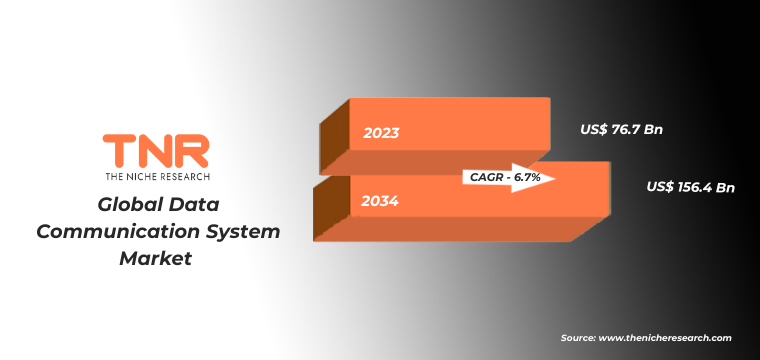
| Component | Example | Industry Vertical | Use Cases/Application |
| Hardware | Routers and Switches | Telecommunications | Routers manage data traffic between networks, while switches connect devices within a network, enabling efficient data transfer in telecom companies like Verizon (2023). |
| Fiber Optic Cables | Healthcare | Fiber optic cables provide high-speed data transmission for telemedicine applications, facilitating remote patient monitoring and consultations, essential during the COVID-19 pandemic (2020). | |
| Software | Network Management Software | IT and Telecom | Software solutions like SolarWinds allow organizations to monitor and optimize network performance, crucial for managing large data centers in cloud service providers (2023). |
| Secure Communication Protocols | Financial Services | Protocols like SSL/TLS ensure secure data transfer in online banking transactions, protecting sensitive information in banks like JP Morgan (2023). | |
| Services | Cloud Data Services | Retail | Services such as Amazon Web Services (AWS) enable retailers to store, process, and analyze customer data in real-time, enhancing e-commerce operations and inventory management (2023). |
| Managed Network Services | Manufacturing | Companies like Cisco provide managed services that help manufacturers maintain and optimize their communication networks, ensuring seamless operations in smart factories (2023). |
Global Data Communication System Market Dynamics:
Growth Drivers in the Global Data Communication System Market
- 5G Network Expansion: The rapid deployment of 5G networks is a significant growth driver in the global data communication system market. 5G enables ultra-fast data transfer, essential for industries like autonomous vehicles, smart cities, and telemedicine. For example, 5G networks empower real-time V2X communication in self-driving cars, enhancing safety and traffic management.
- IoT Proliferation: The increasing use of IoT devices across various sectors, including manufacturing, healthcare, and agriculture, boosts demand for reliable data communication systems. IoT devices continuously exchange data, requiring robust networks to manage the massive data flow. In smart factories, IoT sensors monitor equipment, ensuring timely maintenance and reducing downtime.
- Cloud Computing and Data Centers: The rise of cloud computing and the need for efficient data centers drive the demand for advanced data communication systems. Enterprises are migrating to cloud services for scalability and flexibility. In the financial sector, real-time data exchange through cloud systems ensures faster, secure financial transactions globally, driving growth in this market.
Restraints in the Global Data Communication System Market
- High Infrastructure Costs: Deploying advanced data communication systems, particularly 5G networks and IoT infrastructure, requires significant investments. For example, telecom companies face high costs in upgrading towers and laying fiber-optic cables. In rural areas, these expenses delay network expansion, slowing market growth in certain regions.
- Data Security and Privacy Concerns: As more data flows through communication systems, concerns about cyberattacks and data breaches intensify. In sectors like healthcare, where sensitive patient data is transmitted through telemedicine platforms, ensuring security is critical. These concerns may limit widespread adoption of data communication technologies, especially in high-risk industries.
- Regulatory Challenges: Strict regulations governing data usage and cross-border data transfer can hinder market expansion. For instance, in the European Union, the General Data Protection Regulation (GDPR) imposes stringent data protection laws, complicating the deployment of global data communication systems. These compliance requirements can increase operational costs and slow adoption.
Global Data Communication System Market Segmental Analysis
By Component
Software segment dominate the global data communication system market, contributing 43.6% to revenue share due to its pivotal role in managing, securing, and optimizing data flow across industries. Software solutions like network management tools, communication protocols, and cybersecurity applications ensure smooth and efficient data exchange. For example, in the financial sector, advanced encryption software secures real-time transactions. Similarly, cloud-based software in manufacturing enhances connectivity for IoT devices, enabling real-time monitoring and predictive maintenance. The flexibility and scalability of software-based solutions make them crucial across sectors like telecommunications, healthcare, and automotive, driving significant market growth.
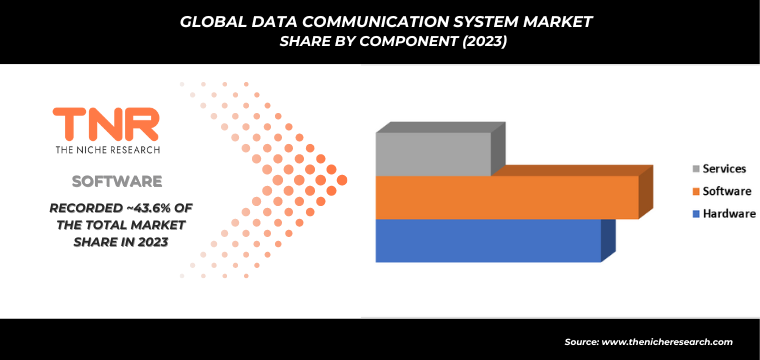
By Enterprise Size
In 2023, the large enterprises segment accounted for 43.7% of the global data communication system market, becoming the second-largest enterprise size category. Large organizations heavily rely on advanced data communication systems to manage vast data volumes, ensuring real-time connectivity across global branches. For instance, multinational banks utilize secure, high-speed data networks for financial transactions and global operations. Similarly, automotive giants depend on communication systems to synchronize supply chains, monitor production, and enable connected car technologies. The need for robust infrastructure, scalability, and enhanced cybersecurity in industries like manufacturing, healthcare, and telecommunications further drives large enterprises’ adoption of these solutions.

By Connectivity
The wired segment is set to be the fastest-growing connectivity in the global data communication system market, projected to account for 23.9% of the revenue share. Wired connections, such as fiber-optic networks, offer superior speed, stability, and security compared to wireless alternatives, making them ideal for industries requiring uninterrupted data flow. For example, data centers and financial institutions rely on wired communication to ensure fast, reliable data transfers for large transactions. Similarly, in manufacturing, wired networks are preferred for industrial automation systems, where real-time data transmission is critical for seamless operations and minimal downtime.
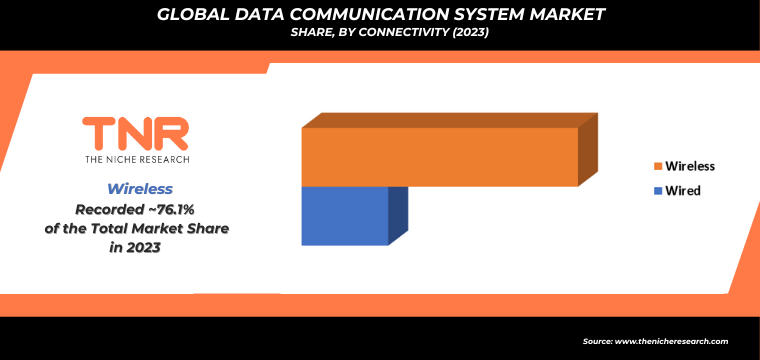
By Industry Vertical
IT and telecom segment by industry vertical dominated the global data communication system market, capturing 15.5% of revenue share due to its crucial role in enabling high-speed, reliable communication networks. Telecom companies, like Verizon and AT&T, depend on advanced data systems to support growing demands for 5G, IoT, and cloud services. Similarly, IT firms use robust communication infrastructure to manage global operations, data centers, and cybersecurity protocols. For example, cloud service providers rely on efficient data networks to offer seamless services to clients across industries, driving growth in both the IT and telecom sectors through enhanced connectivity and data management.
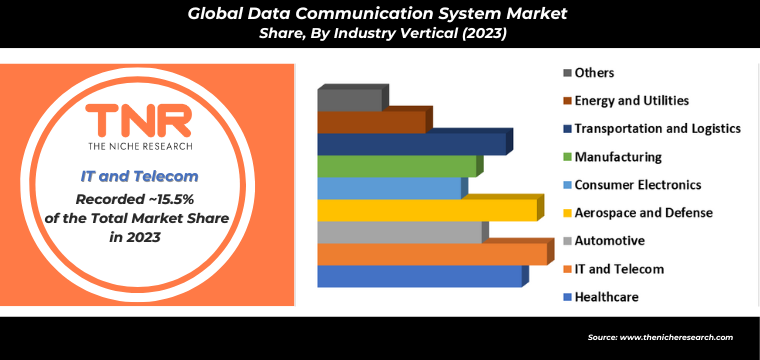
By Region
In 2023, Europe reinforced its second leading position in the global data communication system market, capturing a significant revenue share of 29.6%. The region’s focus on digital transformation, 5G deployment, and data security regulations like the GDPR drives demand for advanced communication systems. For example, Germany is investing heavily in smart factories using IoT and AI, which rely on seamless data communication. Additionally, telecom companies across France and the UK are expanding their fiber-optic networks to support high-speed connectivity. Europe’s emphasis on cybersecurity and innovation in sectors like automotive and healthcare further boosts the region’s market share.
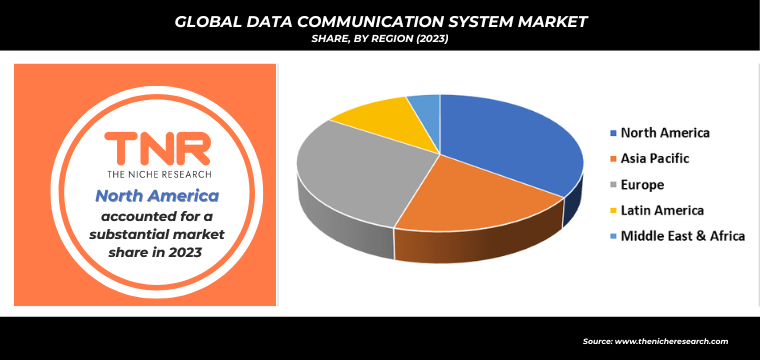
Competitive Landscape
Some of the players operating in the data communication system market are
- Arista Networks, Inc.
- Broadcom Inc.
- Cisco Systems, Inc.
- Dell Technologies Inc.
- Ericsson
- Extreme Networks, Inc.
- Fujitsu Limited
- Hewlett Packard Enterprise (HPE)
- Huawei Technologies Co., Ltd.
- IBM Corporation
- Juniper Networks, Inc.
- NEC Corporation
- Nokia Corporation
- Siemens AG
- ZTE Corporation
- Other Industry Participants
Global Data Communication System Market Scope:
| Report Specifications | Details |
| Market Revenue in 2023 | US$ 76.7 Bn |
| Market Size Forecast by 2034 | US$ 156.4 Bn |
| Growth Rate (CAGR) | 6.7% |
| Historic Data | 2016 – 2022 |
| Base Year for Estimation | 2023 |
| Forecast Period | 2024 – 2034 |
| Report Inclusions | Market Size & Estimates, Market Dynamics, Competitive Scenario, Trends, Growth Factors, Market Determinants, Key Investment Segmentation, Product/Service/Solutions Benchmarking |
| Segments Covered | By Component, By Enterprise Size, By Connectivity, By Industry Vertical, By Region |
| Regions Covered | North America, Europe, Asia Pacific, Middle East & Africa, Latin America |
| Countries Covered | U.S., Canada, Mexico, Rest of North America, France, The UK, Spain, Germany, Italy, Nordic Countries (Denmark, Finland, Iceland, Sweden, Norway), Benelux Union (Belgium, The Netherlands, Luxembourg), Rest of Europe, China, Japan, India, New Zealand, Australia, South Korea, Southeast Asia (Indonesia, Thailand, Malaysia, Singapore, Rest of Southeast Asia), Rest of Asia Pacific, Saudi Arabia, UAE, Egypt, Kuwait, South Africa, Rest of Middle East & Africa, Brazil, Argentina, Rest of Latin America |
| Key Players | Arista Networks, Inc., Broadcom Inc., Cisco Systems, Inc., Dell Technologies Inc., Ericsson, Extreme Networks, Inc., Fujitsu Limited, Hewlett Packard Enterprise (HPE), Huawei Technologies Co., Ltd., IBM Corporation, Juniper Networks, Inc., NEC Corporation, Nokia Corporation, Siemens AG, ZTE Corporation |
| Customization Scope | Customization allows for the inclusion/modification of content pertaining to geographical regions, countries, and specific market segments. |
| Pricing & Procurement Options | Explore purchase options tailored to your specific research requirements |
| Contact Details | Consult With Our Expert
Japan (Toll-Free): +81 663-386-8111 South Korea (Toll-Free): +82-808- 703-126 Saudi Arabia (Toll-Free): +966 800-850-1643 United Kingdom: +44 753-710-5080 United States: +1 302-232-5106 E-mail: askanexpert@thenicheresearch.com
|
Global Data Communication System Market
By Component
- Hardware
- Software
- Services
By Enterprise Size
- Small and Medium Enterprises (SMEs)
- Large Enterprises
By Connectivity
- Wired
- Wireless
By Industry Vertical
- Healthcare
- IT and Telecom
- Automotive
- Aerospace and Defense
- Consumer Electronics
- Manufacturing
- Transportation and Logistics
- Energy and Utilities
- Others
By Region
- North America (U.S., Canada, Mexico, Rest of North America)
- Europe (France, The UK, Spain, Germany, Italy, Nordic Countries (Denmark, Finland, Iceland, Sweden, Norway), Benelux Union (Belgium, The Netherlands, Luxembourg), Rest of Europe)
- Asia Pacific (China, Japan, India, New Zealand, Australia, South Korea, Southeast Asia (Indonesia, Thailand, Malaysia, Singapore, Rest of Southeast Asia), Rest of Asia Pacific)
- Middle East & Africa (Saudi Arabia, UAE, Egypt, Kuwait, South Africa, Rest of Middle East & Africa)
- Latin America (Brazil, Argentina, Rest of Latin America)
Report Layout:
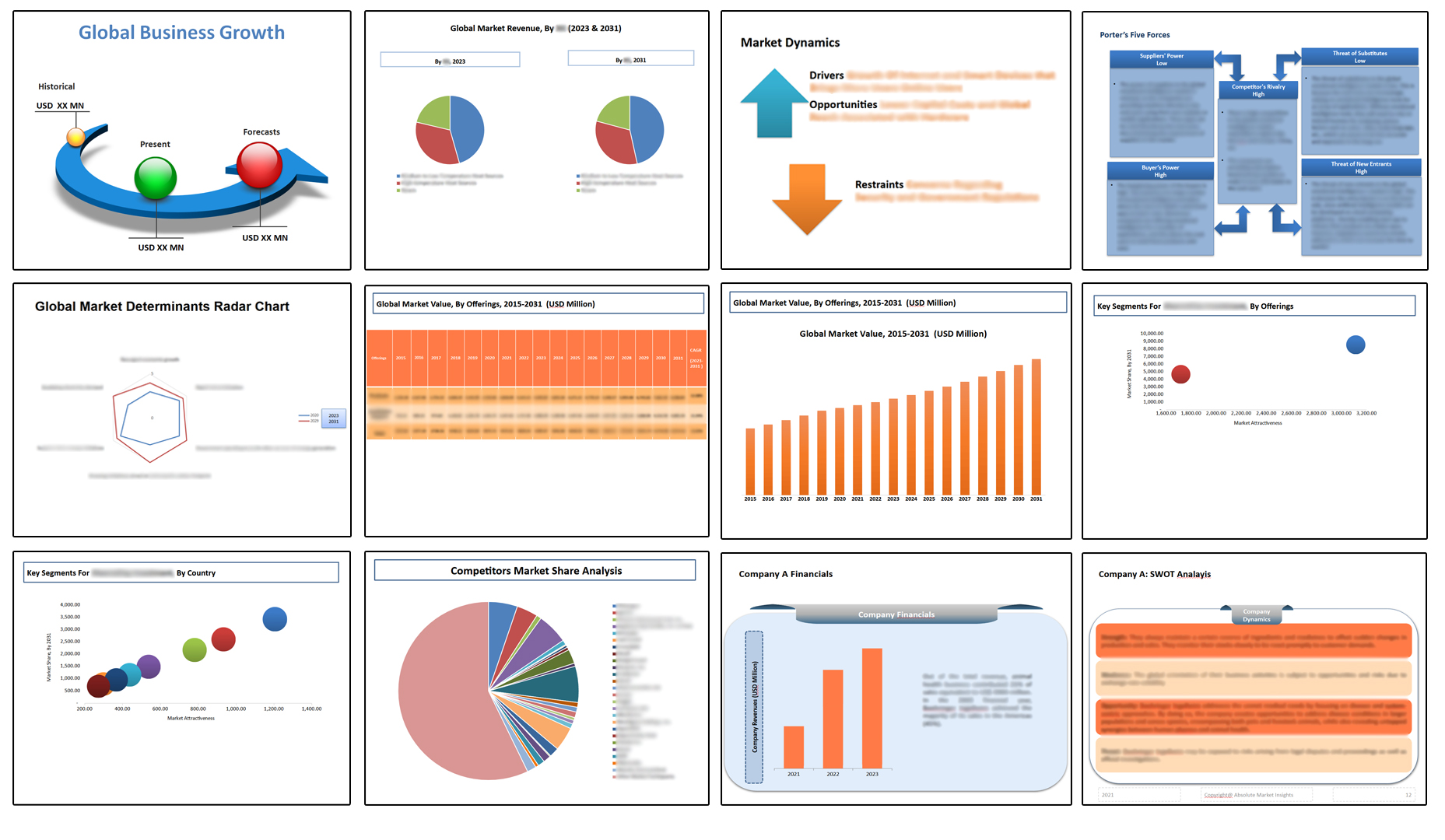
Table of Contents
Note: This ToC is tentative and can be changed according to the research study conducted during the course of report completion.
**Exclusive for Multi-User and Enterprise User.
Global Data Communication System Market
By Component
- Hardware
- Software
- Services
By Enterprise Size
- Small and Medium Enterprises (SMEs)
- Large Enterprises
By Connectivity
- Wired
- Wireless
By Industry Vertical
- Healthcare
- IT and Telecom
- Automotive
- Aerospace and Defense
- Consumer Electronics
- Manufacturing
- Transportation and Logistics
- Energy and Utilities
- Others
By Region
- North America (U.S., Canada, Mexico, Rest of North America)
- Europe (France, The UK, Spain, Germany, Italy, Nordic Countries (Denmark, Finland, Iceland, Sweden, Norway), Benelux Union (Belgium, The Netherlands, Luxembourg), Rest of Europe)
- Asia Pacific (China, Japan, India, New Zealand, Australia, South Korea, Southeast Asia (Indonesia, Thailand, Malaysia, Singapore, Rest of Southeast Asia), Rest of Asia Pacific)
- Middle East & Africa (Saudi Arabia, UAE, Egypt, Kuwait, South Africa, Rest of Middle East & Africa)
- Latin America (Brazil, Argentina, Rest of Latin America)
The Niche Research approach encompasses both primary and secondary research methods to provide comprehensive insights. While primary research is the cornerstone of our studies, we also incorporate secondary research sources such as company annual reports, premium industry databases, press releases, industry journals, and white papers.
Within our primary research, we actively engage with various industry stakeholders, conducting paid interviews and surveys. Our meticulous analysis extends to every market participant in major countries, allowing us to thoroughly examine their portfolios, calculate market shares, and segment revenues.
Our data collection primarily focuses on individual countries within our research scope, enabling us to estimate regional market sizes. Typically, we employ a bottom-up approach, meticulously tracking trends in different countries. We analyze growth drivers, constraints, technological innovations, and opportunities for each country, ultimately arriving at regional figures.Our process begins by examining the growth prospects of each country. Building upon these insights, we project growth and trends for the entire region. Finally, we utilize our proprietary model to refine estimations and forecasts.
Our data validation standards are integral to ensuring the reliability and accuracy of our research findings. Here’s a breakdown of our data validation processes and the stakeholders we engage with during our primary research:
- Supply Side Analysis: We initiate a supply side analysis by directly contacting market participants, through telephonic interviews and questionnaires containing both open-ended and close-ended questions. We gather information on their portfolios, segment revenues, developments, and growth strategies.
- Demand Side Analysis: To gain insights into adoption trends and consumer preferences, we reach out to target customers and users (non-vendors). This information forms a vital part of the qualitative analysis section of our reports, covering market dynamics, adoption trends, consumer behavior, spending patterns, and other related aspects.
- Consultant Insights: We tap into the expertise of our partner consultants from around the world to obtain their unique viewpoints and perspectives. Their insights contribute to a well-rounded understanding of the markets under investigation.
- In-House Validation: To ensure data accuracy and reliability, we conduct cross-validation of data points and information through our in-house team of consultants and utilize advanced data modeling tools for thorough verification.
The forecasts we provide are based on a comprehensive assessment of various factors, including:
- Market Trends and Past Performance (Last Five Years): We accurately analyze market trends and performance data from preceding five years to identify historical patterns and understand the market’s evolution.
- Historical Performance and Growth of Market Participants: We assess the historical performance and growth trajectories of key market participants. This analysis provides insights into the competitive landscape and individual company strategies.
- Market Determinants Impact Analysis (Next Eight Years): We conduct a rigorous analysis of the factors that are projected to influence the market over the next eight years. This includes assessing both internal and external determinants that can shape market dynamics.
- Drivers and Challenges for the Forecast Period:Identify the factors expected to drive market growth during the forecast period, as well as the challenges that the industry may face. This analysis aids in deriving an accurate growth rate projection.
- New Acquisitions, Collaborations, or Partnerships: We keep a close watch on any new acquisitions, collaborations, or partnerships within the industry. These developments can have a significant impact on market dynamics and competitiveness.
- Macro and Micro Factors Analysis:A thorough examination of both macro-level factors (e.g., economic trends, regulatory changes) and micro-level factors (e.g., technological advancements, consumer preferences) that may influence the market during the forecast period.
- End-User Sentiment Analysis: To understand the market from the end-user perspective, we conduct sentiment analysis. This involves assessing the sentiment, preferences, and feedback of the end-users, which can provide valuable insights into market trends.
- Perspective of Primary Participants: Insights gathered directly from primary research participants play a crucial role in shaping our forecasts. Their perspectives and experiences provide valuable qualitative data.
- Year-on-Year Growth Trend: We utilize a year-on-year growth trend based on historical market growth and expected future trends. This helps in formulating our growth projections, aligning them with the market’s historical performance.
Research process adopted by TNR involves multiple stages, including data collection, validation, quality checks, and presentation. It’s crucial that the data and information we provide add value to your existing market understanding and expertise. We have also established partnerships with business consulting, research, and survey organizations across regions and globally to collaborate on regional analysis and data validation, ensuring the highest level of accuracy and reliability in our reports.









